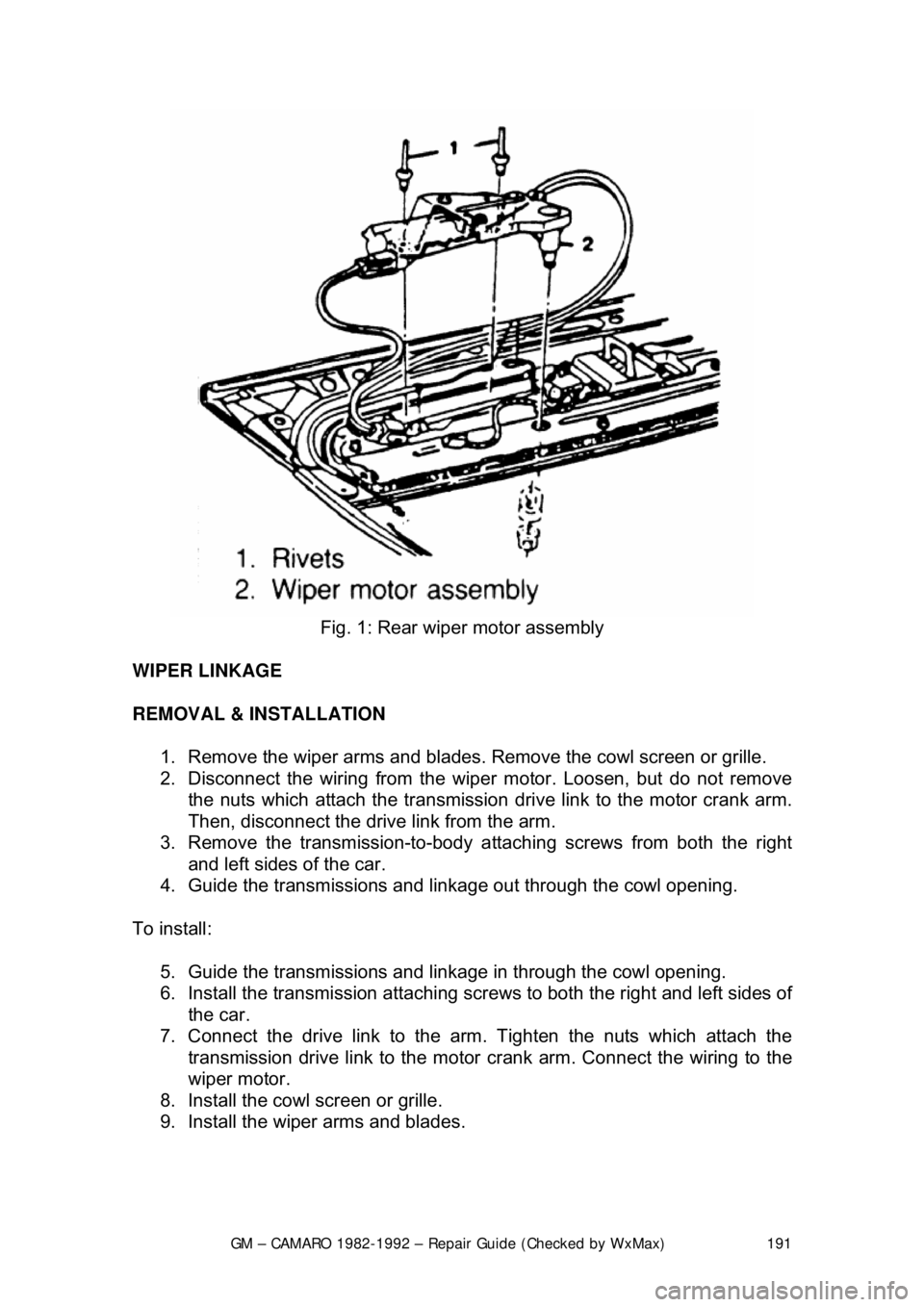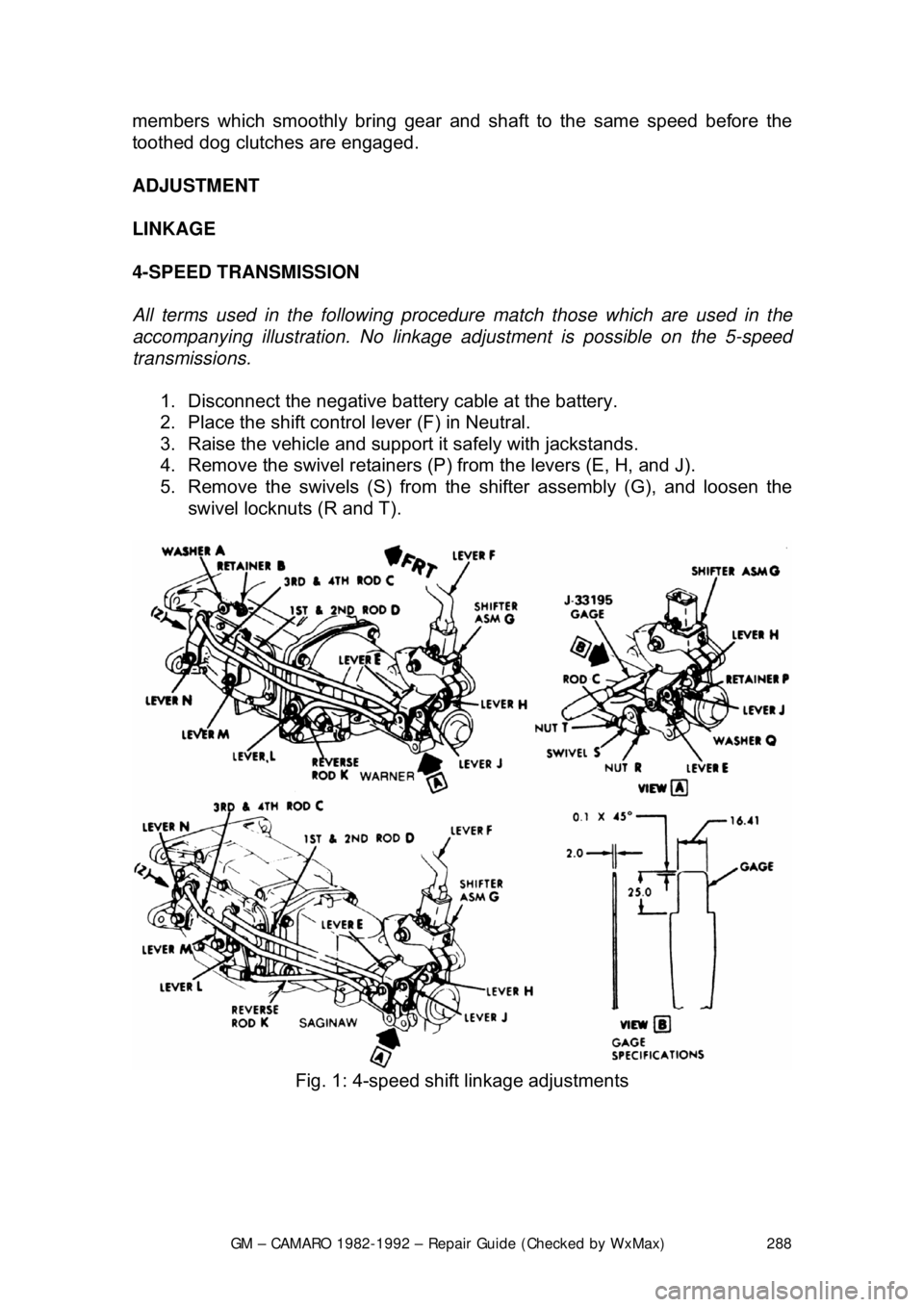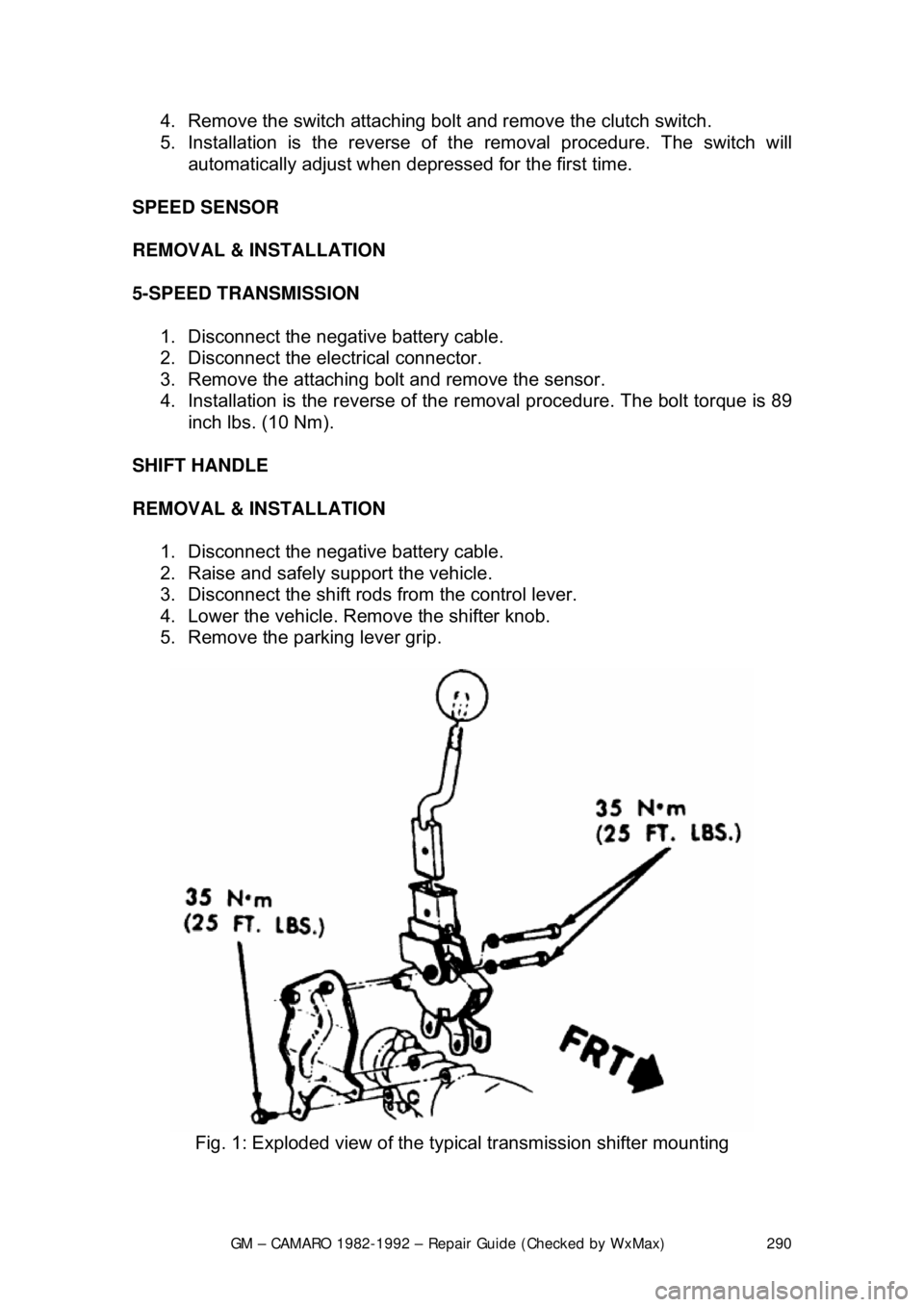1982 CHEVROLET CAMARO transmission
[x] Cancel search: transmissionPage 187 of 875

GM – CAMARO 1982-1992 – Repair Guide (Checked by WxMax) 187
Fig. 6: Be sure to line up the splines on the driveshaft with the grooves in the
arm when installing
WINDSHIELD WIPER MOTOR
REMOVAL & INSTALLATION 1. Disconnect the negative batte ry cable at the battery.
2. Remove the screen or grille that covers the cowl area.
3. Working under the hood, disconnec t the motor wiring. Then, reach
through the cowl opening and loosen, but do not remove, the nuts which
attach the transmission drive link to the motor crank arm. Then,
disconnect the drive link from the crank arm.
4. Remove the three motor attach ing screws, and remove the motor,
guiding the crank arm through the hole.
To install: 5. Position the motor, guiding the crank arm thr ough the hole, and install
the 3 motor attaching screws.
6. Connect the drive link to the cran k arm and connect the motor wiring.
The motor must be in the park position before assemb ling the crank arm to the
transmission drive link(s).
7. Install the screen or grille that covers the cowl area.
8. Connect the negative battery cable at the battery.
Page 191 of 875

GM – CAMARO 1982-1992 – Repair Guide (Checked by WxMax) 191
Fig. 1: Rear wiper motor assembly
WIPER LINKAGE
REMOVAL & INSTALLATION 1. Remove the wiper arms and blades. Remove the cowl screen or grille.
2. Disconnect the wiring from the wiper motor. Loosen, but do not remove
the nuts which attach the transmission drive link to the motor crank arm.
Then, disconnect the drive link from the arm.
3. Remove the transmission-to-body a ttaching screws from both the right
and left sides of the car.
4. Guide the transmissions and link age out through the cowl opening.
To install: 5. Guide the transmissions and linkage in through the cowl opening.
6. Install the transmission attaching scr ews to both the right and left sides of
the car.
7. Connect the drive link to the arm. Tighten the nuts which attach the
transmission drive link to the motor cr ank arm. Connect the wiring to the
wiper motor.
8. Install the cowl screen or grille.
9. Install the wiper arms and blades.
Page 287 of 875

GM – CAMARO 1982-1992 – Repair Guide (Checked by WxMax) 287
DRIVE TRAIN
MANUAL TRANSMISSION
UNDERSTANDING THE MANUAL TRANSMISSION
Because of the way an internal combus tion engine breathes, it can produce
torque (or twisting force) only withi n a narrow speed range. Most overhead
valve pushrod engines must turn at about 2500 rpm to produce their peak
torque. Often by 4500 rpm, they are prod ucing so little torque that continued
increases in engine speed produce no power increases.
The torque peak on overhead camshaft engines is, generally, much higher, but
much narrower.
The manual transmission and clutch are employed to vary the relationship
between engine RPM and the speed of the w heels so that adequate power can
be produced under all circumst ances. The clutch allows engine torque to be
applied to the transmission input shaft gradually, due to mechanical slippage.
The vehicle can, consequently, be star ted smoothly from a full stop.
The transmission changes the ratio between the rotating speeds of the engine
and the wheels by the use of gears. 4-speed or 5-speed transmissions are most
common. The lower gears al low full engine power to be applied to the rear
wheels during acceleration at low speeds.
The clutch driveplate is a thin disc, the center of which is splined to the
transmission input shaft. Both sides of the disc are covered with a layer of
material which is similar to brake li ning and which is capable of allowing
slippage without roughness or excessive noise.
The clutch cover is bolted to the engine flywheel and incorporates a diaphragm
spring which provides the pressure to engage the clutch. The cover also houses
the pressure plate. When the clutch pe dal is released, the driven disc is
sandwiched between the pressu re plate and the smooth surface of the flywheel,
thus forcing the disc to turn at th e same speed as the engine crankshaft.
The transmission contains a mainshaft which passes all the way through the
transmission, from the clutch to the dr iveshaft. This shaft is separated at one
point, so that front and rear portions can turn at different speeds.
Power is transmitted by a countershaft in the lower gears and reverse. The
gears of the countershaft mesh with gear s on the mainshaft, allowing power to
be carried from one to the other. Countershaft gears are often integral with that
shaft, while several of the mainshaft gea rs can either rotate independently of
the shaft or be locked to it. Shifting from one gear to the next causes one of the
gears to be freed from rotating with the shaft and locks another to it. Gears are
locked and unlocked by internal dog clutc hes which slide between the center of
the gear and the shaft. The forward gears us ually employ synchronizers; friction
Page 288 of 875

GM – CAMARO 1982-1992 – Repair Guide (Checked by WxMax) 288
members which smoothly bring gear and
shaft to the same speed before the
toothed dog clutches are engaged.
ADJUSTMENT
LINKAGE
4-SPEED TRANSMISSION
All terms used in the following procedure match those which are used in the
accompanying illustration. No linkage adjustment is possible on the 5-speed
transmissions.
1. Disconnect the negative batte ry cable at the battery.
2. Place the shift control lever (F) in Neutral.
3. Raise the vehicle and support it safely with jackstands.
4. Remove the swivel retainers (P) from the levers (E, H, and J).
5. Remove the swivels (S) from the shifter assembly (G), and loosen the
swivel locknuts (R and T).
Fig. 1: 4-speed shift linkage adjustments
Page 290 of 875

GM – CAMARO 1982-1992 – Repair Guide (Checked by WxMax) 290
4. Remove the switch attaching bo
lt and remove the clutch switch.
5. Installation is the reverse of t he removal procedure. The switch will
automatically adjust when depres sed for the first time.
SPEED SENSOR
REMOVAL & INSTALLATION
5-SPEED TRANSMISSION 1. Disconnect the negative battery cable.
2. Disconnect the electrical connector.
3. Remove the attaching bolt and remove the sensor.
4. Installation is the reverse of the removal procedure. The bolt torque is 89
inch lbs. (10 Nm).
SHIFT HANDLE
REMOVAL & INSTALLATION 1. Disconnect the negative battery cable.
2. Raise and safely support the vehicle.
3. Disconnect the shift rods from the control lever.
4. Lower the vehicle. Remove the shifter knob.
5. Remove the parking lever grip.
Fig. 1: Exploded view of the typi cal transmission shifter mounting
Page 291 of 875

GM – CAMARO 1982-1992 – Repair Guide (Checked by WxMax) 291
6. Remove the console cover.
7. Remove the shifter boot.
8. Remove the shifter mounting bolt
s and remove the shifter assembly.
9. Installation is the reverse of the removal procedure. Adjust the linkage as
detailed earlier.
BACK-UP LIGHT SWITCH
REMOVAL & INSTALLATION 1. Disconnect the negative battery terminal from the battery.
2. At the left-rear of the transmission, the back-up light switch is threaded
into the transmission case. The speed sensor is held in with a separate
bracket. Disconnect the electrical co nnector from the back-up light
switch.
3. Remove the back-up light swit ch from the transmission.
4. To install, reverse the remova l procedures. Coat the threads with
Teflon® tape. Please refer to the to rque chart for specifications. Place
the gear shift lever in the revers e position and check that the back-up
lights work.
EXTENSION HOUSING SEAL
REMOVAL & INSTALLATION
This seal controls transmission oil leakage around the driveshaft. Continued
failure of this seal usually indicates a worn output shaft bushing. If so, there will
be signs of the same wear on the driveshaft where it contacts the seal and
bushing. The seal is available and is fairly simple to install, with the proper tool.
1. Raise and safely support the rear of the vehicle to minimize transmission
oil loss when the driveshaft is removed.
2. Unbolt the driveshaft fr om the differential and center support bearing, if
equipped. Wrap tape around the bearing cu ps to keep them in place on
the universal joint and slide the sh aft out of the transmission.
3. Use an small pry tool to carefully pry out the old seal. Be careful not to
insert the tool too far into the hous ing or the bushing will be damaged.
Page 292 of 875

GM – CAMARO 1982-1992 – Repair Guide (Checked by WxMax) 292
Fig. 1: Installing the extension housing seal
4. Use an oil seal installation tool to evenly drive the new seal into the
housing. Make sure the tool only cont acts the outer metal portion of the
seal.
5. Install the driveshaft. Torque the uni versal bearing cup retainer bolts to
15 ft. lbs. (20 Nm).
TRANSMISSION
REMOVAL & INSTALLATION
On 5-speed transmissions remove the shif t lever boot and the shift lever prior to
transmission removal.
1. Disconnect the negative batte ry cable at the battery.
2. Raise the vehicle and support it safely with jackstands.
3. Drain the lubricant from the transmission.
Page 293 of 875

GM – CAMARO 1982-1992 – Repair Guide (Checked by WxMax) 293
4. Remove the torque arm from t
he vehicle as outlined under Rear
Suspension in
Suspension & Steering of this repair guide.
5. Mark the driveshaft and the rear ax le pinion flange to indicate their
relationship. Unbolt the rear universal joint straps. Lower the rear of the
driveshaft, being careful to keep the universal joint caps in place.
Withdraw the driveshaft from the transmission and remove it from the
vehicle.
6. Disconnect the speedometer cable a nd the electrical connectors from the
transmission.
7. Remove the exhaust pipe brace.
8. Remove the transmission shifter support attaching bolts from the
transmission.
9. On 4-speed transmissions only, disconnec t the shift linkage at the shifter.
10. Raise the transmission slight ly with a jack, then remove the
crossmember attaching bolts.
11. Remove the transmission mount atta ching bolts, then remove the mount
and crossmember from the vehicle.
12. Remove the transmission attachi ng bolts, then with the aid of an
assistant, move the transmission r earward and downward out of the
vehicle.
To install: 13. Apply a light coating of high temperature grease to the main drive gear
bearing retainer and to the splined por tion of the main drive gear. This
will assure free movement of the clutch and transmission components
during assembly.
14. Install the transmission and secu re with transmission mounting bolts
Torque transmission-to-clutch housing bo lts to 55 ft. lbs. (74 Nm).
15. Install the mount and cr ossmember into the vehicle, then install the
transmission mount attaching bolts. Torque both the mount-to-
crossmember bolts and t he mount-to-transmission bolts to 35 ft. lbs. (47
Nm).
16. Install the crossmember attach ing bolts. Torque the crossmember-to-
body bolts to 35 ft. lbs.
17. On 4-speed transmissions only, connect the shift linkage at the shifter and adjust the shift linkage.
18. Install the transmission shifte r support attaching bolts to the
transmission. Torque shifter bracket-to -extension housing to 25 ft. lbs.
(35 Nm).
19. Install the exhaust pipe brace.
20. Connect the speedometer cable and the electrical connectors to the
transmission.
21. Install the driveshaft into the tr ansmission. Then, align the marks on the
driveshaft and the rear axle pinion fl ange. Bolt the rear universal joint
straps.
22. Install the torque arm into the vehicle.
23. Fill the transmission wi th lubricant. Then install the filler plug and torque
to 15 ft. lbs. (20 Nm).
24. Lower the vehicle.